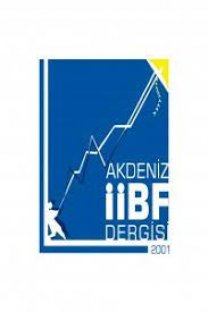Beklenen kayıp yöntemi ile riske maruz değer analizi
Uygulamalı çalışmalar, finansal varlık getirilerinin şişman kuyruklu olduklarını ve büyük bir kısmının volatilite kümelenmesi ve asimetri ile karakterize edildiklerini göstermektedir. Bu çalışmada, iki farklı dönem (normal ve kriz) açısından çeşitli dağılımlara göre Genelleştirilmiş Asimetrik Üslü ARCH (APGARCH) modeli uygulanarak günlük hisse senedi getirileri için Riske Maruz Değer (VaR) ve Beklenen Kayıp (ES) tutarları hesaplanmıştır. İstanbul Menkul Kıymetler Borsası’nda kısa ve uzun pozisyon alan yatırımcılar için VaR ve ES hesaplamalarının normal, Student-t ve GED dağılımlarına kıyasla Skewed (Çarpık) Student-t dağılımlı APGARCH modeli ile daha doğru modellendiği anlaşılmıştır.
Value at risk analysis with expected shortfall
Empirical studies have shown that a large number of financial asset returns exhibit fat tails and are often characterized by volatility clustering and asymmetry. This paper provides Value at Risk (VaR) and Expected Shortfall (ES) estimations for daily stock returns in two different periods (normal and crises) with the application of Generalized Asymmetric Power ARCH (APGARCH) model according to different error distribution assumptions. The results show that the estimated VaR and ES for traders having both short and long positions in the Istanbul Stock Exchange is more accurately modeled by a Skewed Student-t APARCH model that by a normal, Student-t or GED distributions.
___
- ACERBI, C. ve TASCHE, D. (2002) On The Coherence Of Expected Shortfall, Journal of Banking and Finance, 26, 1487–1503.
- ARTZNER, P., DELBAEN, F., EBER, J-M. ve HEATH, D. (1999) Coherent Measures of Risk, Mathematical Finance, 9, 203-228.
- ANÉ, T. (2006) An Analysis of the Flexibility of Asymmetric Power GARCH Models, Computational Statistics and Data Analysis, 51, 1293-1311.
- BASAK, S. ve SHAPIRO, A. (2001) Value-at-Risk Based Risk Management: Optimal Policies and Asset Prices, Review of Financial Studies, 14, 371-405.
- BERKOWITZ, J. ve O’BRIEN, J. (2002) How Accurate Are Value-at-Risk Models At Commercial Banks?, Journal of Finance, 57, 1093–1111.
- BOLLERSLEV, T, ENGLE, R.F. ve NELSON, D.B. (1994) ARCH Models, (Ed.: ENGLE, R.F. ve MCFADDEN, D.L.), Handbook of Econometrics, North Holland Press, Amsterdam, 2959–3038.
- BOLLERSLEV, T. (1987) A Conditionally Heteroskedastic Time Series Model for Speculative Prices and Rates of Return, The Review of Economics and Statistics, 69(3), 542-547.
- BOZKUŞ, S. (2005),Risk Ölçümünde Alternatif Yaklaşımlar: Riske Maruz Değer (VaR) ve Beklenen Kayıp (ES) Uygulamaları, Dokuz Eylül Üniversitesi, İktisadi ve İdari Bilimler Fakültesi Dergisi, 20(2), 27-45.
- BROOKS, R.D., FAFF, R.W., MCKENZIE, M.D. ve MITCHELL, H. (2000) A Multi-country Study of Power ARCH Models and National Stock Market Returns, Journal of International Money and Finance, 19, 377–397.
- ÇİFTER, A. (2004) Risk Yönetimi’nde (Skewed) Student-t ve GED Dağılımları ile Asimetrik ve (Kısmi) Entegre GARCH Modelleri: Eurobond Üzerine Bir Uygulama, VIII. Ulusal Finans Sempozyumu,İstanbul Teknik Üniversitesi, 2004.
- ÇİFTER, A., ÖZÜN, A. ve YILMAZER, S. (2007) Beklenen Kuyruk Kaybı ve Genelleştirilmiş Pareto Dağılımı ile Riske Maruz Değer Öngörüsü: Faiz Oranları Üzerine Bir Uygulama, Bankacılar Dergisi, Türkiye Bankalar Birliği, 60, 3-16.
- DING, Z., GRANGER, C.W.J. ve ENGLE, R.F. (1993) A Long Memory Property of Stock Market Returns and A New Model, Journal of Empirical Finance, 1, 83-106.
- DOWD, K. (2002), Measuring Market Risk, John Wiley&Sons Ltd., England.
- FERNANDEZ, C. ve STEEL, M.F.J. (1998) On Bayesian Modelling of Fat Tails and Skewness, Journal of the American Statistical Association, 93, 359-371.
- GIOT, P. ve LAURENT, S. (2003) Value-at-Risk For Long And Short Trading Positions, Journal of Applied Econometrics, 18, 641–664.
- JONDEAU, E., POON, S.H. ve Rockinger, M. (2007) Financial Modeling Under Non-Gaussian Distributions, Springer Finance, USA.
- JORION, P. (2003) Financial Risk Manager Handbook, 2nd Edition, John Wiley&Sons Ltd., USA.
- JORION, P. (2000) Value at Risk: The New Benchmark for Managing Financial Risk, 2nd Edition, McGraw Hill Inc., New York.
- DIMANDIS, P.F., KOURETAS, G.P. ve ZARANGAS, L. (2006) Value-at-Risk for Long and Short Trading Positions: The Case of the Athens Stock Exchange, Working Paper, University of Crete, Department of Economics, No:601.
- KUPIEC, P.H. (1995) Techniques for Verifying The Accuracy Of Risk Measurement Models, Journal of Derivatives, 3, 73–84.
- LAMBERT, P. ve LAURENT, S. (2001) Modelling Financial Time Series Using GARCH-Type Models with a Skewed Student Distribution For The Innovations, Universite Catholique de Louvain, Institut de Statistique, Discussion Paper, No:125, Belgium.
- LAURENT S. ve PETERS, J.P. (2000) G@RCH 1.11: An Ox Package for Estimating Various ARCH Models, Faculty of Economy, Business and Social Science, University of Liège, Belgium, October.
- LAURENT S. (2007) G@RCH 5.0 Help, http://www.garch.org,(30.03.2008).
- PAN, H. ve ZHANG, Z. (2006) Forecasting Financial Volatility: Evidence From Chinese Stock Market, Working Paper in Economics and Finance, University of Durham, 06/02, 1-29.
- YAMAI, Y. ve YOSHIBA, T. (2002) Comparative Analyses of Expected Shortfall and Value-at-Risk: Their Estimation Error, Decomposition, and Optimization, Monetary and Economic Studies, Bank of Japan, 20(1),87–122.
- YAMAI, Y. ve YOSHIBA, T. (2005) Value-at-Risk Versus Expected Shortfall: A Practical Perspective, Journal of Banking and Finance, 29, 997–1015.
- ISSN: 1302-9975
- Yayın Aralığı: Yılda 2 Sayı
- Başlangıç: 2001
- Yayıncı: Akdeniz Üniversitesi
